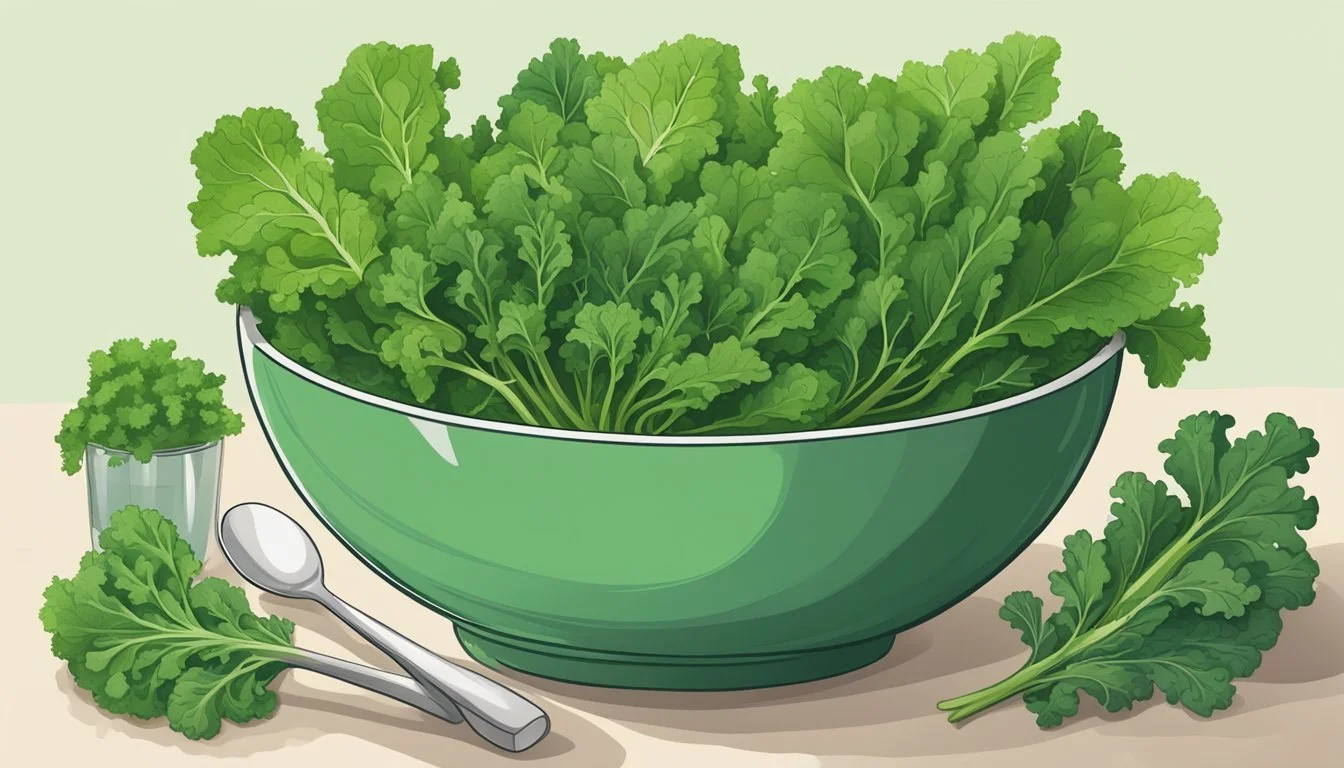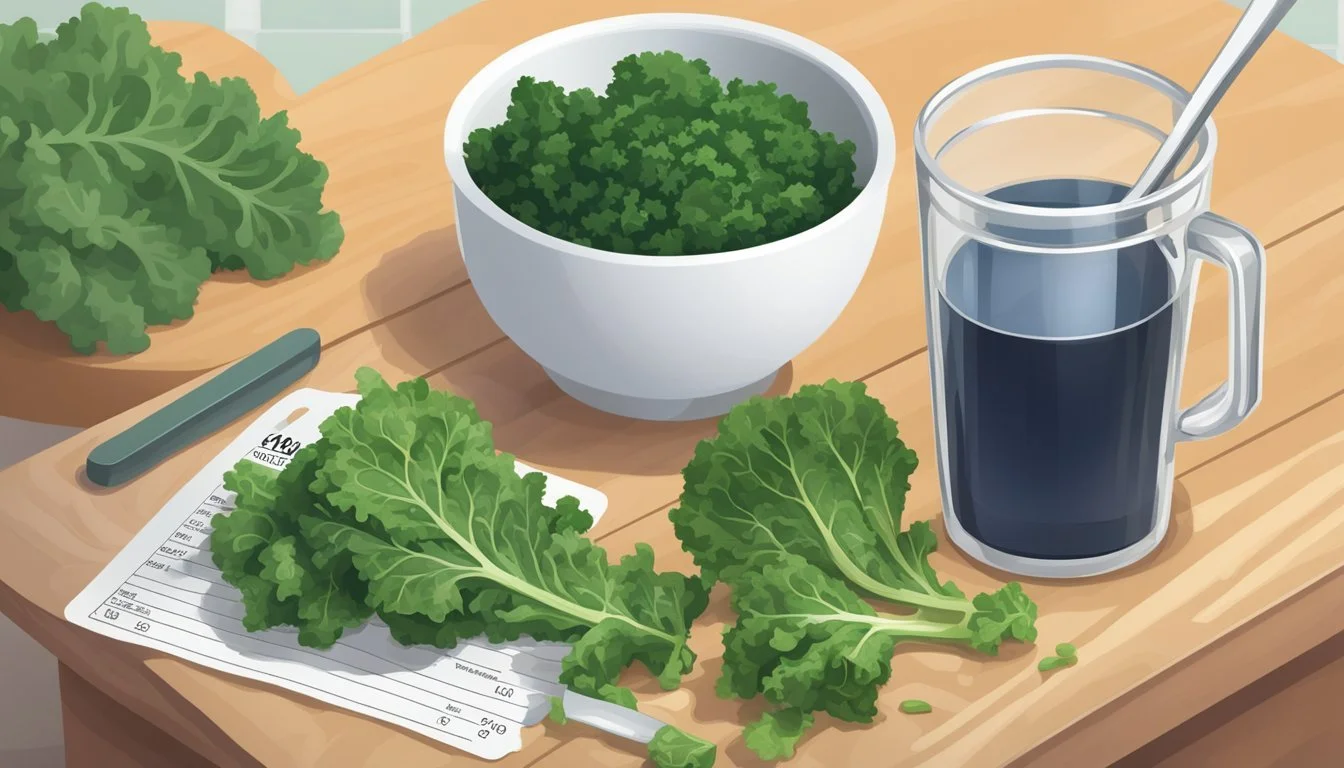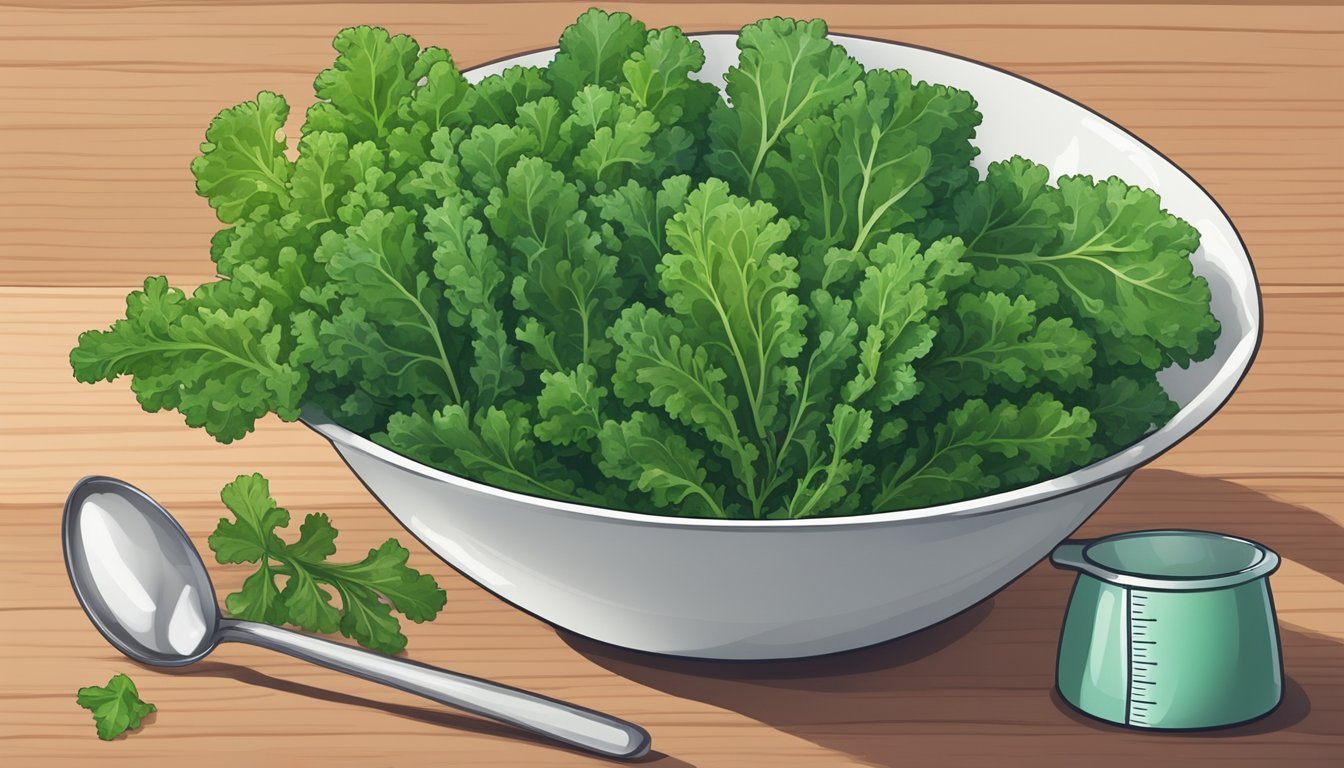How Many Cups of Kale You Need for Your Daily Vitamin K Intake
Kale (What wine goes well with kale?) is a leafy green vegetable recognized for its exceptional nutrient richness, and one of its standout vitamins is vitamin K. This essential nutrient plays a critical role in blood clotting and bone health. A single cup of cooked kale offers a substantial portion of the recommended daily intake of vitamin K for adults, which can vary from 75 to 120 micrograms depending on age and gender.
Incorporating kale into one's diet is a highly efficient way to meet these dietary needs, as even a small serving contains a significant amount of the vitamin. For instance, just one cup of raw kale provides over 67% of the daily recommended value for adult men over age 19, and an even higher percentage for women, who require less of this vitamin daily. Eating kale, whether cooked or raw, adds valuable nutrients to any diet and helps contribute toward the vegetable intake recommended by dietary guidelines.
Understanding Vitamin K
Vitamin K is an essential nutrient that plays a critical role in blood clotting and overall health. This section explores the functions of vitamin K, its daily recommendations, dietary sources, and specifically, the significance of kale as a source of this important vitamin.
Functions of Vitamin K
Vitamin K is crucial for synthesizing proteins required for blood clotting. This helps prevent excessive bleeding when injuries occur. Additionally, vitamin K contributes to bone health, working in tandem with other nutrients like calcium and vitamin D.
Daily Recommended Intake of Vitamin K
According to the Dietary Guidelines for Americans, adults need between 75 to 120 micrograms (mcg) of vitamin K per day. This varies slightly by age, sex, and life stage.
Vitamin K Sources
Vitamin K is predominantly found in green vegetables, particularly leafy greens and cruciferous vegetables. Common sources include:
Leafy greens: spinach, lettuce
Cruciferous vegetables: broccoli, cabbage, and Brussels sprouts
Role of Kale in Vitamin K Consumption
Kale, a leafy green vegetable, is a powerhouse for vitamin K. One cup of cooked kale provides approximately 544 mcg of vitamin K, which is significantly higher than the daily requirement, making it a valuable addition to the diet.
Comparison with Other Vitamin K-Rich Foods
While kale stands out as a rich source of vitamin K, other foods such as spinach, cabbage, and broccoli also contribute to the intake of this nutrient. However, cooked kale tends to have a higher vitamin K content per cup compared to these other vegetables.
Vitamin K and Blood Thinners
Individuals taking blood thinners like warfarin should monitor their vitamin K intake as it can affect the medication's efficacy. Anticoagulant medications work to prevent clots, and a consistent intake of vitamin K is crucial for maintaining the desired therapeutic effect. It is advisable to consult with healthcare professionals to manage the intake of vitamin K-rich foods, including kale.
Kale: A Nutritional Overview
Kale is a nutrient-dense leafy green that is often referred to as a superfood. It is part of the cruciferous vegetable family and is known for its high vitamin and mineral content as well as its health-promoting properties.
Nutritional Content of Kale
Kale boasts a remarkable nutrient profile. A single cup of raw kale provides:
Calories: 33 kcal
Protein: 2.9 g
Fiber: 1.3 g
Vitamins:
Vitamin A: 206% of the Reference Daily Intake (RDI)
Vitamin C: 134% of the RDI
Vitamin K: 684% of the RDI
Minerals:
Calcium: 9% of the RDI
Potassium: 9% of the RDI
Manganese: 26% of the RDI
Health Benefits of Kale
Kale is laden with antioxidants such as beta-carotene, vitamin C, and flavonoids like quercetin and kaempferol. These substances help counteract oxidative damage by free radicals and may offer protection against chronic diseases. Regular consumption of kale may aid in:
Cancer Prevention: Compounds in kale may have protective effects against cancer.
Bone Health: High in calcium and vitamin K, kale is beneficial for maintaining strong bones.
Heart Health: The potassium content in kale can help manage blood pressure.
Anti-inflammatory: The nutrients in kale can help reduce inflammation.
Eye Health: Lutein and zeaxanthin, found in kale, are linked to a lower risk of macular degeneration.
Different Types of Kale
There are various types of kale, each with its unique taste and texture:
Curly Kale: Well-known for its ruffled leaves and fibrous stalk, it has a pungent flavor and is great in salads.
Dinosaur Kale: Also known as lacinato or Tuscan kale, it has long, bumpy leaves and a slightly sweeter taste compared to other varieties.
Baby Kale: These are the young leaves of the kale plant, tender and mild in flavor, perfect for salads without the need for cooking.
Preparation and Consumption of Kale
Kale is a versatile green and can be prepared in numerous ways, making it easy to incorporate into meals:
Salads: Raw, tender kale leaves can be used in salads, often massaged with a dressing to soften the leaves.
Soups and Stews: Kale can withstand long cooking times, making it an excellent addition to soups and stews.
Smoothies: Baby kale is often added to smoothies for a nutrient boost without a strong flavor.
Steamed or Sautéed: Steaming or sautéeing kale is a common method, which can make it easier to digest and help unlock certain nutrients.
Kale Chips: Baked kale chips are a crunchy alternative that offers the nutritional benefits of kale in a snackable form.
The variety of ways to prepare kale allows it to contribute to a healthy and balanced diet. Whether it is added to soups, smoothies, or enjoyed as a hearty salad, kale provides a wealth of nutrients beneficial for overall health.
Diet and Nutrition
Kale is a nutrient-dense vegetable that provides a substantial amount of vitamin K, which is essential for blood clotting and bone health. It is also low in calories, making it an ideal choice for those looking to maintain a balanced diet. Eating just one cup of cooked kale can deliver more than the daily adequate intake of vitamin K for adults.
Incorporating Kale into a Balanced Diet
Kale can be easily included in one's diet given its versatility and health benefits. It is high in vitamins A, C, and K, as well as minerals like potassium and calcium, supporting overall health and potentially reducing the risk of chronic diseases such as cancer, heart disease, and type 2 diabetes. Kale can be consumed raw in salads, blended in smoothies, or cooked in a variety of dishes. Here is a concise look at its nutritional profile per one cup:
Calories: 7.2
Protein: 0.6g
Carbohydrates: 0.9g
Fat: 0.3g
Fiber: not specified, but generally high
Dietary Considerations and Restrictions
People following plant-based or vegetarian diets will find kale to be a beneficial addition to their food choices because of its dense nutrient content and low calorie count. However, one should be mindful of potential nutrient deficiencies, such as iodine, which is crucial for preventing hypothyroidism. Kale does not contain iodine, so individuals should ensure they receive this mineral from other sources.
Food Synergy and Combining Nutrients
Consuming kale in combination with other foods can enhance nutrient absorption. For example, pairing kale with vitamin C-rich fruits can boost iron absorption. Combining it with healthy fats, like those found in olive oil or avocados, can increase the bioavailability of its fat-soluble vitamins. This concept of food synergy maximizes the health benefits of a balanced diet by leveraging the complementary effects of different nutrients.
Potential Health Concerns
Consuming kale as a way to increase vitamin K intake is generally safe for most people. However, there are certain health concerns associated with kale that should be considered, especially when consumed in large amounts.
Kale and Oxalate Content
Kale contains oxalates, natural compounds found in many vegetables that can contribute to kidney stone formation in susceptible individuals. High oxalate levels can lead to the development of calcium oxalate stones, particularly in those who may have a predisposition for this condition.
Interactions with Medications
Kale is rich in vitamin K, which is known to affect blood coagulation. Warfarin, a common anticoagulant or blood thinner used to prevent blood clots and manage cardiovascular disease, can interact with foods high in vitamin K, like kale. Individuals taking warfarin or similar blood thinners should manage their kale intake to prevent fluctuations in medication effectiveness.
Allergies and Intolerances
Though relatively rare, some individuals may experience allergic reactions to kale, presenting symptoms such as itching, hives, or swelling. Those with known allergies to other cruciferous vegetables should approach kale with caution due to possible cross-reactivity.
Iodine and Thyroid Function
Kale belongs to the cruciferous vegetable family and is known to contain compounds called glucosinolates, which can impact thyroid function. Excessive consumption may contribute to an iodine deficiency, leading to hypothyroidism in susceptible individuals. Anyone with thyroid concerns should be mindful of their kale intake and seek advice from a healthcare provider.
Shopping and Storage
When considering the intake of vitamin K from kale, consumers should focus on selecting the freshest produce and employing proper storage techniques to maximize the leafy green's nutrient profile and flavor.
Selecting High-Quality Kale
Curly kale and green leafy varieties remain the most prevalent types. When selecting fresh kale, one should look for firm, deeply colored leaves with hardy stems. The color of the leaves should range from dark green to purple, indicative of rich carotenoid content. Leaves should be free from yellowing and signs of wilting to ensure optimal flavor and extended shelf life.
Storing Kale to Preserve Nutrients
To maintain kale's vitamin K content, proper storage is crucial:
Refrigeration: Kale should be stored in the refrigerator to slow down the decay process. The ideal temperature for maximizing shelf life is just above 0°C (32°F).
Keeping it Dry: Before refrigerating, kale should not be washed as moisture can promote spoilage. Instead, kale can be loosely wrapped in a paper towel to absorb excess moisture and then placed in a plastic bag with air holes for circulation, which can keep it fresh for up to a week.
Freezing: For longer preservation, kale can be blanched and then frozen. This process involves briefly boiling the kale and then plunging it into ice water to halt the cooking process, helping to retain the nutrients and flavor.
By selecting high-quality kale and adhering to these storage guidelines, the consumer ensures they benefit from the maximum vitamin K and carotenoids that kale has to offer.
Culinary Uses and Recipes
Incorporating kale into one's diet allows for a creative exploration of its versatility in the kitchen. From its robust flavor to its low calorie count, kale can be a pivotal ingredient in a balanced diet, whether through raw applications in salads or cooked presentations in soups and sautés.
Cooking Techniques for Kale
Steaming: By steaming kale for 5 to 10 minutes, one retains most of its nutrients, softens the fibers, and diminishes its natural bitterness, making it a gentle addition to any plate.
Sautéing: Quick and flavorful, sautéing kale in a bit of olive oil with garlic and a pinch of salt enhances its flavor, creating a perfect side dish that's both nutrient-rich and calorie-conscious.
Kale Chips: For a light snack, one can bake kale leaves tossed in olive oil at 350°F (175°C) for 10-15 minutes until crisp, seasoning it to taste.
Soups: Adding chopped kale to soups during the last few minutes of cooking ensures that it retains its texture and vitamin content.
Creative Kale Recipes
Salads: Young, tender kale leaves are ideal for salads. They can be massaged with a bit of olive oil to soften them up, then tossed with an assortment of vegetables, seeds, nuts, and a vinaigrette dressing for a wholesome and balanced meal.
Kale Smoothies: A blend of 1-2 cups of kale leaves with a liquid base such as almond milk or orange juice, frozen fruits, and additional ingredients like nut butter, yogurt, or chia seeds creates a nutrient-packed smoothie.
Flavor Pairings: When creating recipes, it is beneficial to pair kale with complementary flavors, such as lemon to counteract bitterness or sweet fruits to balance the earthy taste of the kale in smoothies and salads.
One can easily integrate kale into their diet to ensure they are getting ample vitamin K, an essential component for blood clotting and bone health. Each cup of raw kale contains a significant amount of this vitamin, so a couple of cups in a recipe would help meet the daily value for vitamin K intake.







